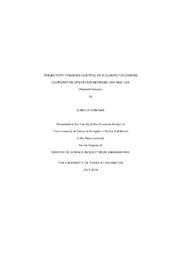
ATTENTION: The works hosted here are being migrated to a new repository that will consolidate resources, improve discoverability, and better show UTA's research impact on the global community. We will update authors as the migration progresses. Please see MavMatrix for more information.
Show simple item record
| dc.contributor.advisor | Lewis, Frank | |
| dc.creator | Fowowe, Ajibola S | |
| dc.date.accessioned | 2017-02-14T15:36:02Z | |
| dc.date.available | 2017-02-14T15:36:02Z | |
| dc.date.created | 2016-12 | |
| dc.date.issued | 2016-12-20 | |
| dc.date.submitted | December 2016 | |
| dc.identifier.uri | http://hdl.handle.net/10106/26370 | |
| dc.description.abstract | In recent times, there has been an increase in the use and application of unmanned aerial vehicles (UAVs). UAVs are used for various operations ranging from military applications to civilian purposes such as traffic monitoring, photography, surveillance and others. Within the UAV family, rotorcrafts take precedence over the fixed wing aircraft especially because of their unique features such as vertical takeoff and landing, increased payload, high maneuverability and more. They can be used to perform dangerous tasks and access environments that pose danger to man such as observatory wood and building fire, military purposes etc.
This project focused on one of the various applications of the UAVs; cooperative operations between UAVs and ground vehicles. Scenarios may arise where we need the UAV to take on independent surveillance task in an unknown environment. I present a complete solution for the visual navigation of a small-scale, low-cost quadrotor in unknown environments.
My approach relies solely on a monocular camera as the main sensor and therefore does not need external tracking aids like GPS or visual markers. Computations are carried out on an external laptop that communicates over wireless LAN with the quadrotor using Robot Operating System (ROS). This approach consists of three major components: a monocular SLAM system for pose estimation, an extended Kalman filter, which includes a full model of the drone’s flight and control dynamics to fuse and synchronize all available data and to compensate for delays arising from the communication process and the computations required and lastly, a PID controller to control the position and orientation of the drone.
During the cooperative operation, the ground vehicle acts as the master, a mobile launch/landing pad for the UAV. Cooperative operation between mobile robots can be very critical in complex scenarios such as the UAV mapping out an area for obstacles and optimal navigation path for the UGV, also the UAV can be sent to areas inaccessible by the ground vehicle for observation and it returns back to the ground vehicle after this operation. | |
| dc.format.mimetype | application/pdf | |
| dc.language.iso | en_US | |
| dc.subject | Trajectory | |
| dc.subject | Controls | |
| dc.subject | UAV | |
| dc.subject | UGV | |
| dc.title | TRAJECTORY TRACKING CONTROL OF A QUADROTOR DURING COOPERATIVE OPERATION BETWEEN UAV AND UGV | |
| dc.type | Thesis | |
| dc.degree.department | Electrical Engineering | |
| dc.degree.name | Master of Science in Electrical Engineering | |
| dc.date.updated | 2017-02-14T15:38:09Z | |
| thesis.degree.department | Electrical Engineering | |
| thesis.degree.grantor | The University of Texas at Arlington | |
| thesis.degree.level | Masters | |
| thesis.degree.name | Master of Science in Electrical Engineering | |
| dc.type.material | text | |
| dc.creator.orcid | 0000-0002-9623-0753 | |
Files in this item
- Name:
- AJIBOLA FOWOWE 1001149268.pdf
- Size:
- 1.215Mb
- Format:
- PDF
- Description:
- Ajibola Fowowe Revised Version
This item appears in the following Collection(s)
Show simple item record


